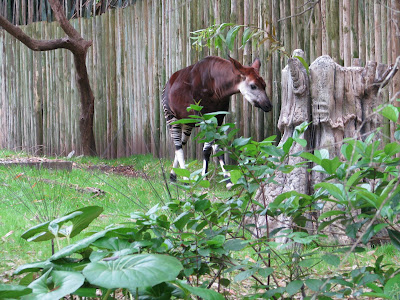Disney's Animal Kingdom transports you to Africa on the Pangani Forest Exploration Trail. One of the featured species is the Okapi, which for many is not a household name. On the Trail you will get a chance to see the Okapi as they play their role in the detailed story that the Disney Imagineers have created.
Disney World is about entertainment, which is why you shouldn't confuse Disney's Animal Kingdom with a zoo. Disney has created a theme park full of stories around a central theme of animals and uses live animals and their habitats to help make the stories real and believable.
The animal based attractions are not merely animals in a cage or small habitat, they are there as characters in the story that is being told. When you encounter them you become part of this interactive story. As is often the case, you can enjoy the attraction for merely the entertainment value at the surface, or you can choose to look more closely at all of the details and get a deeper understanding of the story. Those that take the time to see all of the detail usually come away with a more rewarding experience.
This example of the okapi is one of many that you may have passed by without realizing all of the details and elements of the story that existed for those who wished to look a little closer.
Okapi
The okapi is an animal that is only found in the Congo Basin "Ituri Rainforest." In order to include the okapi as part of the story, the Disney Imagineers have created a back story that has the Ituri Wildlife Preserve in Zaire, Africa sending 3 okapi to the Harambe Wildlife Reserve so that they can be studied in this new habitat.
As a Disney World Park guest you are immersed in the research station and can see the work of the researchers of the okapi. If you are so inclined you can read some of their research that is posted and gain a further understanding of this seldom seen species that has been on the protected list since 1933.
The closest relative to the okapi is the giraffe. Some of the similarities that they share are:
- both have very long tongues for grasping leaves.
- both lack true horns, but have head knobs that are skin covered bones.
- both lack upper incisors or canines.
- both have basically the same body shape.
The theory is that the giraffe developed the longer neck in order to reach food in the sparse Savannah Grasslands. The okapi reside in the dense rainforest, so plentiful food is within easier reach, not requiring the long neck.
The okapi are shy creatures that prefer to be by themselves as opposed to large groups. They primarily use the sense of sound to detect predators, which is why they have such large ears. Interestingly they have scent glands in their hoofs and use them to mark their territories in the forest.
They have striping on their rump that helps camouflage them in the forest.
The detail that the Disney Imagineers go to create the backgrounds for their stories is amazing. The bulletin board pictured above is a prime example. Each paper or article on the board was created to substantiate the story.
The "article" from The Weekly Journal details the arrival of the 3 okapis at the Harambe Wildlife Reserve from their home at the Ituri Wildlife Preserve. There is also a "letter" from the director of the Ituri Wildlife Preserve passing along helpful information about the habits and needs of the okapi to the director of the Harambe Wildlife Reserve. There is even a "flyer" for an upcoming presentation by "K Kolunda - the Director of the Harambe Wildlife Reserve" announcing the Sunday Lecture entitled "The Natural History Of A Forest Ghost."
The Disney World Guest that takes the time to check out the information posted on the bulletin boards learns about the okapi through the telling of the "story" of their arrival from Zaire and the work of the researchers. This technique provides an entertaining story for the guest and they come away learning something in the process.
The habits and traits of the okapi are further explained through the use of research and observation logs of each of the 3 okapi. By glancing at these logs, you learn more about these interesting creatures.
Using the research logs is a much more effective way to pass along information about the habits and traits of the okapi than just having a list of okapi facts.
The okapi themselves are beautiful creatures that reside in natural habitats and have the top notch Disney Animal Care staff looking out for their well-being.
The above picture is a close-up of the "letter" from the bulletin board from the Director of the Ituri Okapi Project discussing the eating habits and traits of the okapi. By clicking on the picture it will enlarge so you can read it for yourself.
Become Part Of The Disney World Stories
Disney World is so much more than a typical theme park. Through the creation of highly themed attractions and back stories that tie them together the Disney Imagineers create an experience that draws people back again and again.
Although the Disney World attractions are still enjoyable when you rush through them, they take on a whole new level of enjoyment and satisfaction when you take the time to see the detail that is surrounding you. By paying attention to the detail you learn more about the story that you are immersed in and come away with a more complete experience.
At Disney's Animal Kingdom, there is not just a simple exhibit of a couple of okapis in a natural looking habitat. There is a story waiting for you to become a part of it!




















okapi seems to be like advanced version of horse :) lol